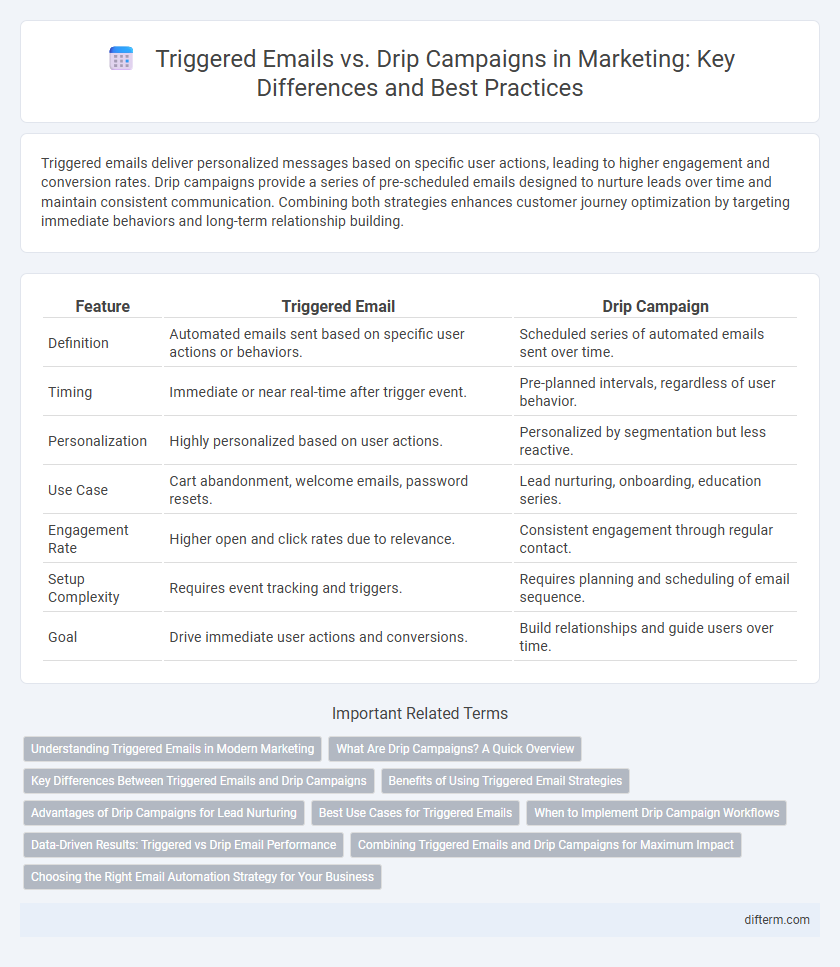Triggered emails deliver personalized messages based on specific user actions, leading to higher engagement and conversion rates. Drip campaigns provide a series of pre-scheduled emails designed to nurture leads over time and maintain consistent communication. Combining both strategies enhances customer journey optimization by targeting immediate behaviors and long-term relationship building.
Table of Comparison
| Feature | Triggered Email | Drip Campaign |
|---|---|---|
| Definition | Automated emails sent based on specific user actions or behaviors. | Scheduled series of automated emails sent over time. |
| Timing | Immediate or near real-time after trigger event. | Pre-planned intervals, regardless of user behavior. |
| Personalization | Highly personalized based on user actions. | Personalized by segmentation but less reactive. |
| Use Case | Cart abandonment, welcome emails, password resets. | Lead nurturing, onboarding, education series. |
| Engagement Rate | Higher open and click rates due to relevance. | Consistent engagement through regular contact. |
| Setup Complexity | Requires event tracking and triggers. | Requires planning and scheduling of email sequence. |
| Goal | Drive immediate user actions and conversions. | Build relationships and guide users over time. |
Understanding Triggered Emails in Modern Marketing
Triggered emails in modern marketing are automated messages sent in response to specific user actions, such as cart abandonment or sign-ups, ensuring timely and relevant communication. These emails significantly improve engagement rates by delivering personalized content when customer intent is highest. Unlike drip campaigns, which follow a pre-set sequence, triggered emails dynamically react to real-time behavior, enhancing conversion and retention.
What Are Drip Campaigns? A Quick Overview
Drip campaigns are automated marketing strategies that send a series of pre-written emails to prospects or customers over a set period, nurturing leads through targeted, timely content. These campaigns are designed to engage recipients based on specific actions or timeline triggers, enhancing conversion rates and customer retention. By delivering consistent, relevant messaging, drip campaigns streamline communication and drive better marketing outcomes.
Key Differences Between Triggered Emails and Drip Campaigns
Triggered emails are automated messages sent based on specific user actions or behaviors, ensuring immediate relevance and personalized engagement. Drip campaigns consist of a series of pre-scheduled emails designed to nurture leads or guide users through a marketing funnel over time. The key difference lies in their timing and responsiveness: triggered emails react to real-time events, while drip campaigns follow a predetermined schedule regardless of user interaction.
Benefits of Using Triggered Email Strategies
Triggered email strategies drive higher engagement rates by delivering personalized, timely content based on user actions, increasing open and conversion rates. These emails enhance customer experience by providing relevant information exactly when the recipient shows interest, fostering stronger brand loyalty. Compared to drip campaigns, triggered emails optimize marketing efficiency through automation that reacts dynamically to individual behavior, reducing wasted impressions.
Advantages of Drip Campaigns for Lead Nurturing
Drip campaigns excel in lead nurturing by delivering personalized, timely content that gradually guides prospects through the buyer's journey, increasing engagement and conversion rates. Their automated and consistent messaging ensures leads receive relevant information based on behavior triggers and lifecycle stages, fostering trust and brand loyalty. Data shows businesses using drip campaigns see up to a 20% increase in sales opportunities compared to static email blasts.
Best Use Cases for Triggered Emails
Triggered emails excel in personalized marketing by sending timely, behavior-based messages such as cart abandonment reminders and post-purchase follow-ups that boost customer engagement and conversion rates. Their real-time nature ensures relevance, making them ideal for transactional updates, re-engagement prompts, and tailored offers triggered by specific user actions. Leveraging triggered emails effectively can drive higher open rates and foster stronger customer relationships compared to generic drip campaigns.
When to Implement Drip Campaign Workflows
Drip campaign workflows are best implemented when nurturing leads through a structured sequence of emails based on user behavior or specific time intervals, ensuring consistent engagement over a longer period. They drive customer retention by delivering personalized content that gradually educates and motivates prospects toward conversion. Marketers should deploy drip campaigns during onboarding, re-engagement, or before major product launches to build sustained interest and loyalty.
Data-Driven Results: Triggered vs Drip Email Performance
Triggered emails demonstrate a 70.5% higher open rate and 152% higher click-through rate compared to drip campaign emails, according to industry data. These real-time, behavior-based messages generate up to 18 times more revenue per email than traditional drip campaigns. Marketers utilizing triggered emails benefit from precise targeting and personalization driven by user actions, resulting in superior engagement and conversion metrics.
Combining Triggered Emails and Drip Campaigns for Maximum Impact
Combining triggered emails with drip campaigns leverages the strengths of both strategies to maximize customer engagement and conversion rates. Triggered emails provide timely, personalized responses based on user actions, while drip campaigns nurture leads through a structured sequence of content. Integrating these approaches allows marketers to deliver relevant messaging at optimal moments, enhancing the customer journey and boosting ROI.
Choosing the Right Email Automation Strategy for Your Business
Triggered emails deliver personalized messages based on specific customer actions, offering high engagement and timely relevance ideal for nurturing leads and enhancing customer experience. Drip campaigns provide a structured sequence of pre-scheduled emails designed to educate and guide prospects through the sales funnel over time, perfect for ongoing brand awareness and consistent communication. Selecting the right email automation strategy depends on your business goals, customer journey complexity, and the need for real-time interaction versus sustained outreach.
Triggered Email vs Drip Campaign Infographic

 difterm.com
difterm.com